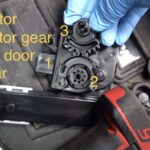The P1496 Paccar Code signals a critical engine protection mode, disabling the Exhaust Gas Recirculation (EGR) system and initiating preventative safety measures. This also halts both passive and active Diesel Particulate Filter (DPF) regeneration. Understanding this code is crucial for maintaining engine performance and ensuring proper emissions control.
Decoding the P1496 Fault Code
The P1496 code itself doesn’t pinpoint a specific problem. It indicates that another underlying fault has triggered a derate condition. This protective mechanism limits engine power by 25-40% to prevent further damage. This power reduction serves as a clear warning to seek professional service. Addressing the root cause is key to resolving the P1496 code.
Underlying Causes of P1496
A wide range of fault codes can trigger the P1496 derate condition. These include issues with sensors, actuators, and other engine components. Some common culprits include:
- Sensor Faults: Problems with sensors like the exhaust gas pressure sensor, intake air pressure sensor, or coolant temperature sensor can disrupt engine operation and trigger the P1496.
- Actuator Malfunctions: Issues with actuators such as the EGR valve, turbocharger actuator, or fuel injectors can also lead to a derate.
- Wiring and Connector Problems: Damaged wiring or loose connectors can disrupt communication between engine components, causing malfunctions and triggering the P1496 code.
- Other System Faults: Problems within the fuel system, exhaust system, or even the engine control module (ECM) itself can be contributing factors.
A comprehensive diagnostic scan using specialized software like Davie 4, OTR Diagnostics, or other dealer-level tools is necessary to pinpoint the specific fault code causing the P1496.
Consequences of Ignoring P1496
If the P1496 code persists for more than 10 hours, it escalates to a permanent derate condition, often indicated by the P1495 code – EGR Disabled Derate Permanent. Clearing this permanent derate requires professional intervention using dealer-level diagnostic tools.
![]()
EGR Delta Pressure Fault on Dashboard
Seeing “EGR Delta Pressure Fault” on your dashboard doesn’t necessarily mean the EGR Delta Pressure sensor is faulty. It often signifies an active EGR derate due to another underlying issue, again highlighting the importance of a thorough diagnostic scan.
Understanding SPN Codes
Kenworth and Peterbilt trucks often display SPN (Suspect Parameter Number) codes instead of standard OBD-II codes. SPN 411 often corresponds to P1495/P1496, indicating the EGR derate. However, relying solely on SPN codes without the corresponding FMI (Failure Mode Identifier) can lead to misdiagnosis. Always use a diagnostic tool to retrieve the complete fault code information. For example, SPN 4796 (P3778) points to a problem with the fuel dosing module, potentially hindering DPF regeneration. This often requires a stationary regeneration or manual clearing using diagnostic software.
Resolving the P1496 Issue
Addressing the P1496 code involves a multi-step process:
- Diagnostic Scan: Use a professional-grade diagnostic tool to identify the specific fault code triggering the derate.
- Repair the Root Cause: Address the underlying issue identified by the diagnostic scan. This may involve replacing faulty sensors, actuators, or repairing wiring issues.
- Clear Fault Codes: After repairs, clear all fault codes using the diagnostic tool.
- Verify Functionality: Test drive the vehicle and monitor for any recurring fault codes or performance issues.
Resolving the P1496 code promptly prevents further engine damage, restores full power, and ensures proper emissions control. Ignoring this critical code can lead to costly repairs and decreased vehicle performance.

